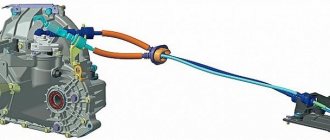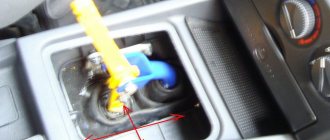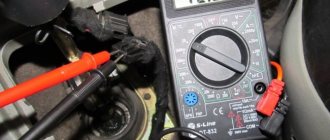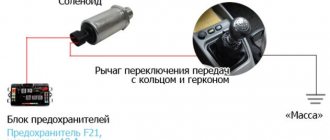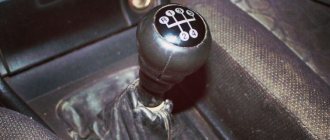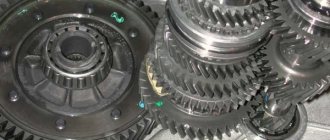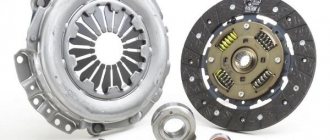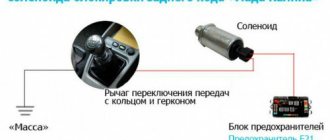06.09.2015 146
The transmission is the most mysterious unit in a car, especially for people who are not technically savvy. And everything seems simple - you squeeze the clutch, push the handle and the car goes. However, if suddenly it doesn’t go, then you don’t know what to think. Therefore, when something happens to the gearbox - reverse gear does not engage , for example, then at least cry.
And if it happens in a garage or in a parking lot, where there are always a lot of advisers who always know exactly why the gear won’t engage, then after several minutes of heated discussions you begin to regret that the gearbox in the car is not an automatic, but a manual transmission. Although automatic transmission is also not without such problems. But let's start in order.
So, reverse gear does not work, what should I do ? Well, for starters, it would be nice to figure out how serious the damage is. To do this, you need to remember how the box behaved in recent days. If nothing has caused concern, then there is hope that not everything is so bad: the transmission is still a complex and reliable element, with a large margin of safety - and it doesn’t just break out of the blue. If reverse gear does not engage, there may be several reasons. We will move from simple to complex.
Crunching sound when engaging reverse gear of Priora
Comments 29
There is no synchronizer in reverse gear, so it should only be engaged when the car is stationary and after 2-3 seconds after turning off the “direct” gear.
Add more oil to the box just above the maximum. + I also turn it on only through 1st gear))))
mileage 90k nothing crunches, I plug everything in the way I want...
Nothing crunches. No matter how you stick it in. Squeeze the main clutch. The oil is synthetic, I changed it right away.
My brother has a coupe on his door, everything turns on easily and simply without any sadness, but on my Prior it’s the same with a crunch, I, like many, turn on any gear, and then reverse, and there are no problems))))) Lada, what can I say !
Everything is fine, it's Priora! There is no synchronizer in the gearbox in reverse gear, hence the crunching noise. There are several points that will help reduce or eliminate this effect: - Turning on with a delay (slow style) - you press down the lever, wait a couple of seconds and turn it on - Turning on after the second (and such a perversion). You engage the second one and then the rear one (and if you stopped and immediately stuck the rear one in, everything is fine) - Adjusting the clutch according to the Murzilka. I don’t remember the essence anymore, but a gap is set under the hood (everything is on the internet) - Better oil in the box (I had normal semi-synthetics to minimize the problem, and the rest of the gears in general began to engage better). Well, fill the oil a little higher than normal
10 cable and adjustment cured this disease, suffered for half a year somewhere)
I don’t know about the click, but there was a crunch www.drive2.ru/c/592333/
it's a Priora! engage reverse through other gears
the teeth of the gear have already been licked
Yes, they put raw meat on gears. I was going through the gearbox on my Kalina because of this, 4 teeth on the reverse gear were chipped, a crack on the input shaft tooth was offset and a mini chip on the first synchronizer ring. I started to get a crunching sound when reversing (coasting with the clutch depressed)
Repair stages
Start by preparing your garage workspace, tools and materials.
- workbench for disassembling the gearbox;
- flushing fluids;
- standard locksmith kit;
- keys and heads;
- capacity for mining;
- rags.
Take care of lighting, exhaust hood, work clothes, and protective equipment (gloves, goggles). Any repair of the Lada Priora gearbox is accompanied by an oil and filter change: buy them in advance.
Dismantling
Removing the box is easy:
- Place the car over the inspection hole and disconnect the battery.
- Drain the oil (this must be done before any intervention in the box).
- Next, disconnect the starter and clutch.
- Place a support under the motor.
- Disengage the wheel drive.
- Unscrew the mounting bolts and remove the box along with the clutch housing.
Workbench for disassembling gearbox
Opening
First, wash the box with Labomid-203. It is necessary to remove the lubricant level indicator. Next, disconnect in sequence:
- covers;
- synchronizer;
- drive gears.
Then remove the shafts and, if necessary, disassemble them.
Parts inspection and troubleshooting
Afterwards, inspect each part, noticing chips on the teeth, cracks on the cast iron body. The latter must be sealed using manual or semi-automatic arc welding: the hot method in special ovens in the garage is impossible.
Inspect bearings and shaft seats. You may need to learn the ironing method to properly prepare the inner surfaces for the bearings.
Discard unusable parts. Make a list according to which you will purchase new items.
Determining the causes of malfunctions
When the box is removed and disassembled, the reasons for its “whims” are revealed:
- If you have removed the unit because the car does not move in any gear, look for a clogged filter, check the oil level, pay attention to the friction discs and brake bands. The reason may lie in the gears of the oil pump and the cuffs in the pistons.
- When only reverse gear works, the culprit may be the valve body valve (VV). Or the o-rings are broken.
- The car slips on inclines - the forward clutch discs are worn out.
- The car only goes backwards - the solenoid in the cylinder head is jammed.
- The car slips when starting, but then the gearbox works normally - perhaps the shaft is slipping due to a broken spline in the valve body hub.
The working life of parts is limited, and careless operation of the car adds wear to the components.
Replacing bearings
Worn bearings are the cause of the howling of the box. To replace elements:
- Remove the unit.
- Remove the back cover and unfasten the cable.
- Remove the coupling - a block with gears, under it you will see a screwed plate.
- Remove fasteners.
- Pry off the plate with screwdrivers and remove.
- Next comes a view of the bearings: replace them with new ones.
Replacing gearbox bearings
Don't forget to remove the boots from the parts to allow oil to flow through.
Replacing the input shaft
The primary shaft is a non-separable design.
It should be changed according to the algorithm:
- Remove the oil level indicator.
- Remove the clutch cable mechanism, then the cover.
- Unscrew the bolt securing one part of the shaft.
- Insert a screwdriver between the shafts to prevent them from turning.
- Now you need to loosen the last nut. It holds the input shaft.
- Remove the component from the box.
Install the new part, reassemble everything in reverse order.
Replacing one or more gears
Buy a repair kit with gears, lock washer, pin, nut and bolt.
- lift;
- wheel wrench;
- set of heads;
- knockouts;
- screwdrivers.
- Drain the oil.
- Remove the left wheel.
- Disconnect the speed sensor connector.
- Remove the back cover.
- After that - the 5th gear fork and its gears.
- Remove the gears, starting with the one behind the fork.
Move on to the second shaft. When you free its last gear, begin assembly, replacing the worn gears with new ones.
Replacement of the secondary shaft, including the assembly
The work is similar to replacing the input shaft:
- Before removing the cover, you need to remove the clutch cable and lubricant level indicator.
- Then unscrew the bolt holding the shaft.
- Secure the shafts from turning.
Now all that remains is to release the last fastener and change the assembly part.
Replacing the reverse gear shaft
The axle is installed in the gearbox block and is held in place by a spring pin. It serves to secure the reverse gear and operates under severe conditions of vibration and increased loads.
Replacing the reverse gear shaft
- Lubricate the axle parts with transmission oil.
- Insert the needle bearing into the shaft hole.
- Then install the reverse gear on the axle, followed by the bushing.
- Press in the spring pin.
Replacing the final drive
Increasing dynamic and driving characteristics is the goal of replacing the main gear. Transmission tuning is a risky activity that only experienced auto mechanics can do:
- First you need to dismantle and wash the box.
- Then remove the back cover.
- Unscrew the 5th gear fastening bolts, remove it as an assembly, then remove its driven gear.
- After that - the retaining rings of the bearings of both shafts and the clutch housing.
- Next, disengage the 1st and 2nd gear forks, then 3rd and 4th gears.
Next comes the reverse gear, both shafts and the differential assembly.
Now you can remove the main gear drive gear:
- Knock out the differential box.
- Remove it from the driven gear hole.
- Install the tuning gears (drive and driven) of the main gear.
Reassemble the box in reverse order.
Replacement or repair of differential
In front-wheel drive cars, the assembly located in the box consists of a crankcase, satellites and side gears. To repair the differential, it must be removed and disassembled.
While everything is disassembled, pay attention to the condition of the gearbox driven gear and when the teeth wear out, replace it together with the driven gear.
Replacing or repairing the gear shift mechanism
When gear shifting is not clear, the drive is to blame. It can be repaired by purchasing a repair kit. Or you can replace it, but it is expensive.
Gear shift mechanism repair
In the first case, gearbox repair on a Priora is accompanied by adjustment.
- Remove the drive.
- Replace the bushings on the hinges.
- Next is the plastic drive triangle.
- Change the rubber bands and bushings on the lever.
After adjustment, connect the shaft and drive, tighten the clamp.
Replacing sensors
The speed sensor is located on the rear of the gearbox housing. You will notice the malfunction when the speedometer readings disappear.
The sensor is held in place by one bolt and is easy to remove. Try first cleaning the part from dust and metal shavings. If manipulations do not lead to anything, change the element.
Such a DIY repair of the Priora gearbox will cost the price of the sensor - 200 rubles.
Housing replacement
If cracks and chips in the gearbox housing cannot be repaired, buy a new housing. The main thing is to choose the same article number as on your unit.
To replace, remove the gearbox. After unscrewing the bolts, remove the front and rear covers and disassemble the box. Then assemble all the parts into a new case.
Replacing seals
O-rings and seals prevent oil leakage from the box. The latter can be replaced with a rubber base. To do this you need:
- Drain the oil.
- Remove the wheel bearing, ball joint, steering knuckle, and axle shaft.
- Then remove the defective oil seal.
- Replace it with a new one, not forgetting to lubricate it with oil.
Do not try to replace the seal on the drive yourself: you will need professional equipment.
Why does the gearbox crunch?
There are many reasons why a crunching noise occurs when the gearbox operates. Eliminating some of them does not require much intervention in the mechanism, while others require a near-overhaul of the box. Most often, the gearbox crunches when changing gears for the following reasons:
Synchronizer malfunction. The problem may lie either in the failure of the element or in the insufficient amount of lubricant in the part. If the synchronizer has “crumbled” due to age, the lubricating components with the resulting “garbage” risk causing serious damage to the entire unit, so the situation needs to be corrected as soon as possible;
Above are only the most common reasons for manual transmission failure. At the same time, we should not forget about possible manufacturing defects.
Diagnostic methods
Do not start the situation if you notice that the box is not working correctly. Carry out the diagnostics yourself:
- Check the oil level and condition.
- Listen to the engine at idle and while driving. As a rule, defects detected by ear can be eliminated by a simple repair of the Priora gearbox in a garage in a couple of hours.
- Check electrical wiring and line pressure.
- Carry out a parking Stell test by manipulating the levers (don't forget to secure the car's wheels with shoes).
In difficult cases, remove the unit completely, but only if you are confident in your knowledge. It is safer to take the car to a car service center, where there are stands, computer diagnostic equipment, special measuring instruments, machines and tools for repairs. There they will find defective components, determine the degree of their wear, and recommend the type of repair.
Creaking and grinding noise when reversing
Creaking and grinding noise when reversing @ Niva 4×4
Nivovodov Club. Founder - Ermolov Alexey Igorevich, aka ALER
NIVA-FAQFAQ mapSpare parts catalogArtNivaFrom adminForum rules
Niva 4×4 / Niva technology / Sounds, vibrations, smells
Reg.: 03/16/2005 Threads / Messages: 2 / 535 From: Capital Age: 36 Car: GMC Truck)
There will be an incomprehensible (metallic) creak. only when driving backwards. It’s not clear where it came from, either from the transfer case or from the front. I was guilty of the protective rings that stand at the output of the shafts from the transfer case (box, axles) and rub against the flange bolts, but they don’t seem to be (not worn). While there is no second person who could listen, I decided to ask. I’ll figure it out, otherwise I’m tired of it already!
the unfortunate animal is the octopus. He has legs from his ears, and his arms from his ass, and his ass itself has ears. and the brains, in fact, are also in the ass.
Reg.: 12/06/2004 Threads / Messages: 628 / 51730
Hmm, I had this happen, when examining the patient, it turned out that the crosspiece on the cardan near the bridge was dying, replacing it with an Italian analogue from the Miteli company fixed everything.
Reg.: 02/24/2005 Threads / Messages: 3 / 396 From: Ivanovo Age: 43 Car: VAZ-21219 (1994), Chevrolet Cruze (2012)
can the crosspieces creak? I also have a quiet, constant creaking, with a slightly floating tone at a steady speed in reverse...
Reg.: 12/06/2004 Threads / Messages: 628 / 51730
can the crosspieces creak? I also have a quiet, constant creaking, with a slightly floating tone at a steady speed in reverse...
I was creaking. They called it the first sign of imminent death. She died 2 thousand later.
Reg.: 03/16/2005 Threads / Messages: 2 / 535 From: Capital Age: 36 Car: GMC Truck)
The question then is this. why only when moving backwards? noticed. It doesn't squeak all the time, but periodically. period along the way - one revolution of the cardan.
the unfortunate animal is the octopus. He has legs from his ears, and his arms from his ass, and his ass itself has ears. and the brains, in fact, are also in the ass.
Reg.: 12/06/2004 Threads / Messages: 628 / 51730
The question then is this. why only when moving backwards? noticed. It doesn't squeak all the time, but periodically. period along the way - one revolution of the cardan.
Then the service center told me: “Uhhh, it took us a long time to catch this sound, no matter how much we dug... It will hold together in one direction, because when moving forward the metal rolled, but in the return it scuffed, etc.” What I bought it for is what I’m selling it for, but My crossguard will also soon fail. Added after 1 minute 45 seconds:
Of course one turn. Usually it is not all parts of the cross that die, but one.
Reg.: 03/16/2005 Threads / Messages: 2 / 535 From: Capital Age: 36 Car: GMC Truck)
can the crosspieces creak? I also have a quiet, constant creaking, with a slightly floating tone at a steady speed in reverse...
Wear of release bearing, springs, forks, gears, synchronizers, shafts
As a rule, all these breakdowns are accompanied by extraneous noise during operation, which is difficult to ignore. Repairs will require dismantling the gearbox and the participation of specialists. Your task is not to delay your visit to the service station. This will save you money and possibly prevent irreversible damage.
We deliberately did not touch upon the problems with engaging reverse gear in an automatic transmission, for the simple reason that automatic transmissions are foolproof from birth - it is very difficult to break them yourself. But the most important thing is that the automatic transmission signals the driver about its problems with characteristic jolts when operating in normal mode. It is impossible not to notice them.
Reverse gear does not engage: common breakdowns
So, if engaging reverse gear is difficult or completely impossible, this breakdown is a common problem that can be encountered in different vehicles when changing gears.
Moreover, the rear does not engage both on manual and automatic transmissions (the reverse speed of the automatic transmission has disappeared). Naturally, in such a situation, it is important to discover the cause of the malfunction and eliminate the breakdown, since it is simply impossible to operate the car normally without reverse gear (the vehicle is actually deprived of reverse gear). Let's figure it out.
Please note that ignoring these symptoms leads to the fact that the reverse gear completely stops engaging after a while. Moreover, prolonged use of a car with such a malfunction can cause more serious problems and the need for expensive repairs of the gearbox and other components of the car.
As for the main malfunctions, we can highlight the following:
So, if the clutch is not completely disengaged, the gearbox is not completely disconnected from the engine. This leads to the fact that all gears are difficult to engage. At the same time, on many cars, first speed and reverse do not have synchronizers. As a result, clutch problems are most noticeable when engaging reverse gear.
In such a situation, when trying to engage a gear, a crunching and grinding noise is heard in the box. To eliminate the breakdown, you need to pay special attention to the clutch (condition of the clutch disc, basket, release bearing, etc.). You also need to check the clutch adjustments, the quality of the pedal, etc.
Article on the topic: Do-it-yourself repair and replacement of the Renault Logan stove
In other words, you first need to exclude breakdowns associated with the operation of the clutch control mechanisms (for example, the clutch pedal is soft, does not fully depress, or falls through). If everything is in order with the pedal and the mechanisms associated with it, you need to remove the clutch itself, troubleshoot individual elements, or immediately change the clutch assembly.
If the car is used in difficult conditions (driving around the city, irregular pace, constantly switching speeds “up” and “down”, short trips, temperature changes, etc.), then the oil in the box requires replacement every 50-60 thousand. km. The fact is that the properties of the liquid change, additives are activated, dirt, products of mechanical wear of the box and various deposits accumulate in the oil.
Often, with old and dirty oil, the transmission begins to perform worse in all gears, but do not rule out the most noticeable problems only when engaging reverse gear. It is also necessary to periodically check the oil level in the gearbox, since its decrease causes increased wear of all gearbox parts, contamination of the lubricant with wear products and difficulty engaging gears.
The solution in such a situation is to adjust the manual transmission gate, which can significantly improve the clarity of the inclusions and obtain the necessary softness. Also, in some cases, owners remove the standard mechanism and install a short-throw slide, but in this case you need to be prepared for the need for more careful adjustment. As for the gearbox rods and drives, these elements must be inspected for possible damage or breakage, after which they are replaced.
So, such operation of the gearbox cannot be considered a breakdown. Rather, it is a feature. To achieve a smooth engagement, you need to practice double-depressing the clutch before engaging reverse gear. Experienced drivers also advise engaging first before engaging reverse gear.
Article on the topic: Installing gas equipment on a diesel engine - is it necessary to bother so much?
Source
Types of gearbox repairs
The controllability of the car, and therefore the safety of the crew, depends on the operation of the gearbox.
After a competent troubleshooting at the service station, they will discuss with you the remaining service life of the unit and the feasibility of restoring the structure. Afterwards they will offer to repair the Lada Priora gearbox:
- capital (with complete disassembly of the unit);
- partial (without removing the installation from the machine).
The first option after comprehensive diagnostics and dismantling includes:
- GTR - torque converter bulkhead;
- hydraulic repair or replacement of its elements;
- maintenance of the electrical network and ECU;
- replacement of consumables.
After assembling, configuring and installing the unit in place, the rocker is adjusted and output diagnostics are carried out.
Repair of the Lada Priora gearbox
Situational repairs may include:
- restoration of shaft journals;
- cleaning of threaded connections (if necessary, restoration);
- cleaning nicks on splines;
- discarding and replacing shaft teeth;
- welding cracks on the body;
- elimination of play in the gear shift lever.
Why does a manual transmission “crunch” and what to do about it?
While taking a test drive in a used car, which I really wanted to buy because of its originality, I suddenly heard a crunching sound in the gearbox. How is it possible, it seems, “mechanics” is the most reliable of transmissions and suddenly this... The manager, of course, tried to convince that everything was in order with the gearbox - well, it crunched once, twice, what a problem... However, for me this The crunch served as a clear signal: you should forget about the purchase.
Old gearbox oil or low level
If the car is not new, then who knows if the gearbox oil was changed and when? You need to change the oil and pray that something worse doesn't happen. If there is a leak, drop by drop a day and you may not notice how the oil leaks out of the box. As a rule, this happens through the gearbox gasket or shaft seals. Over time, the box reacts to this with increased noise, but you might not have noticed this either. It is better to change the oil and replace gaskets with seals at a service station, or on your own if you have a “green” understanding of what you are doing.
Crunching in the gearbox, causes
If we compare different types of transmissions, oddly enough, the most problem-free is the “mechanics”; the manual transmission outperforms the classic “automatic” and many of its varieties in terms of resource. However, as we know, nothing lasts forever, and “mechanics” during operation present surprises, the most common of them. The appearance of a crunch when changing gears. Of course, this unpleasant phenomenon does not cause the car to become completely immobilized, it is only the first sign of a possible serious breakdown, it indicates that problems have already arisen in the manual transmission and we need to start solving them as quickly as possible.
A manual transmission, although a rather complex unit, is nevertheless more conservative compared to an automatic transmission; it has much fewer sensors than an automatic one, and accordingly the control system is less complex. Therefore, breakdowns are most often of a mechanical nature, that is, associated with wear and tear of individual parts and elements.
So, why does the crunch occur?
1. failure of the synchronizer.
This device, by equalizing the rotation speed of gears during gear shifts, ensures a smooth transition from one speed to another. Before the use of synchronizers in manual transmissions, drivers were forced to change the throttle, which added complexity to driving; modern drivers do not have to perform such a mandatory action, they are helped by the synchronizer, but only while it is working. With severe wear, the part is no longer able to synchronize the speed of rotation of the shafts. Therefore, when the gears engage, a crunching sound appears. If this phenomenon occurs when only one of the gears is engaged, then the synchronizer is most likely to blame, which needs to be changed. It must be said that the problem with such a breakdown often arises among owners of front-wheel drive VAZs; the thing is that the engineers of the Volga plant, when designing a manual transmission for a whole family of cars, made a gross mistake, namely, they unsuccessfully selected the gear ratio of the second gear. As a result, when switching speed to second, the transmission elements experience increased loads, primarily the synchronizer.
Such a phenomenon as a crunching sound in the transmission can occur when the primary and secondary transmission shafts wear out. When teeth on gears wear out or bearings fail, alignment may be disrupted. If there are problems with the primary and secondary shafts, a crunch will occur when you engage not one, but several gears at once; it can also be heard while the car is moving in any gear.
By the way, the problem with wear of the shafts can also be determined by the temperature effect, if the gears are switched on smoothly when cold, without crunching, and after the oil in the box has warmed up, it appears, the reason most likely lies precisely in them.
How the gearbox works on the Priora
A vehicle's transmission transmits power and torque from the engine to the drive wheels. The gearbox is its main element - it is a set of mechanisms enclosed in a separate housing that disconnects the transmission from the power unit and changes the speed of the car.
Original box "Priors"
The gearbox in the mechanical version is a multi-stage gearbox, the task of which is to change the speed at the driver’s command. The motor is disconnected by the clutch. It is this that turns off the torque and puts the engine and wheels into idle mode.
The Lada Priora 2170 has a 2-shaft 5-speed manual transmission. The main elements are located inside the housing (crankcase):
- Primary shaft with speed drive gears. The teeth of the forward gears are oblique, while the teeth of the rear gears are straight.
- A secondary shaft with a block of driven gears and an oil sump at the bottom. The gears of the two shafts are in constant mesh.
- A synchronizer consisting of locking rings, a coupling and crackers.
- A lever used to change gears.
Priora manual transmissions are reliable, durable, simply designed mechanisms; you can always find cheap spare parts for their repair.
Since 2014, Lada Priora began to be equipped with a robotic gearbox - manual transmission, often called an automatic transmission. But this is a mistake: the robot represents the same manual transmission, but controlled not by a person, but by an electronic unit (ECU) through automatic switches (actuators). Gear selection, gear shifting, clutch operation - everything happens without driver participation.
The modernized “mechanics” eliminated the need for a clutch pedal and gear shift lever. The place of the latter was taken by the selector knob.
The VAZ Priora gearbox has a huge resource - 200-250 thousand km on the speedometer. However, the roads and the driving style of the owners make their own adjustments. On a Priora, gearbox repairs have to be done at 60-80 thousand mileage.
The gearbox crunches when changing gears: possible malfunctions
When buying a car, many drivers give preference to manual transmission, considering it more reliable. A manual gearbox has several advantages, the main one of which is its unpretentiousness. If we compare a manual transmission with an automatic transmission or a variator, then in the event of damage or failure of any elements of the manual transmission, repairs will cost the driver relatively inexpensively.
With proper operation and timely maintenance, a manual transmission will not require special attention. However, in practice, problems may arise over time in the operation of a manual transmission, as in other components of the car. One of the common problems with manual transmissions is the crunching noise that occurs when shifting the gear lever. In this case, the driver needs to determine the cause and fix the problem.
Main malfunctions of manual transmission and manual transmission
Breaking a gearbox is a costly affair, the only justification for which is the natural wear and tear of parts.
Other reasons for node failure are caused by owner oversight:
- sporty and aggressive driving;
- low-quality gear oil;
- non-original spare parts used for replacement;
- ignoring maintenance deadlines.
You can significantly delay the repair time of the VAZ Priora gearbox if you follow simple rules for operating and maintaining the transmission.
You also need to know the common problems with the box.
Weaknesses of manual transmission:
- oil leaks;
- noise at neutral speed with the engine running, shifting one or more (as well as difficulty, crunching) gears;
- their sudden shutdown;
- box vibration.
External manifestations of malfunctions can be caused by many reasons: wear of the synchronizer, breakage of gears, defective bearings, clutch problems, failure of the box fastening.
The robotic gearbox has its own damage:
- the warning light on the instrument panel lights up;
- while moving, buzzing and howling appear;
- lubricant leaks;
- engine speed increases, but speed does not increase;
- clutch slips;
- there are jerks and jolts of the car in motion;
- The manual transmission spontaneously stops working and the car stops.
Gearbox crunches: signs
While driving or braking the car when shifting the gearbox, the driver may hear extraneous sounds, such as crunching, grinding or crackling.
Moreover, most often, extraneous sounds when turning on the gear lever may appear only in one of the gears, for example, only when switching to first or only when switching to second, etc. Also, when returning the gear lever to the neutral position, an unpleasant cracking or grinding.
It is important to understand that if shifting the gearbox lever to higher or lower speed is accompanied by an incomprehensible crackling or grinding noise, the cause should be determined and eliminated as soon as possible.
TOP 6 common mistakes with manual transmission
Shifting gears without clutch
It sounds very strange, given the type of gearbox, but beginners and drivers who have been driving an automatic for a long time often forget to depress the clutch when shifting.
The result is a strong crunch, and a quick realization of the mistake made. At these moments, the box experiences unforeseen loads due to the fact that at the moment of switching the box is not disconnected from the engine, and therefore is under load. Sometimes such pranks end in licking or, even worse, breaking off fragments of gear teeth. As a result, the mechanism “grinds” itself and the manual transmission is simply inevitable.
Clutch depressed
Many car enthusiasts systematically hold the clutch pedal depressed for a long time. For example, when they are standing at traffic lights or just stopped.
This, at first glance, harmless action leads to increased wear of the clutch disc, but what “suffers” the most is the release bearing, which is tirelessly forced to rotate under load. As a result, it quickly becomes unusable (it buzzes), as a result of which it will require immediate replacement, because there is a risk that it will “scatter” right on the move. By the way, to replace it you will have to remove the box, which is not a cheap pleasure.
Engaging reverse gear without coming to a complete stop
A classic of the genre, the driver tries to quickly turn around in the yard, in a hurry, first and then reverse gears. We hear an unpleasant grinding noise when we obviously try to engage the rear.
The reason is simple: the pilot is trying to engage reverse without making a full stop. This has an extremely negative effect on the teeth of the reverse gears, which slowly become unusable due to licking off on one side. If such an error becomes permanent, the reverse gear will engage worse and worse from time to time, until it completely fails.
Downshifting by two or more
Due to the fact that in a manual transmission the function of selecting gears is assigned to the driver, there is a high probability of engaging an inappropriate gear. In cases with downshifts, this is especially dangerous. After all, if the wheel speed turns out to be higher than the maximum possible in the gear selected by the driver (cutoff), when the clutch is released, extreme engine braking will occur. As a result, not only can the gearbox and clutch fail, but also the timing belt in the engine can jump over a couple of teeth (the chain is no exception, but less often), or even break completely (usually an expensive repair).
In addition, with such sharp engine braking, the drive wheels will slow down momentarily, incomparably with the speed of the car, which can cause the car to fall off the trajectory when turning, especially in winter.
If you drive a manual transmission, you should know which gear is which “maximum speed” and avoid “wrong” downshifts.
Hand on the lever
Many drivers, when moving, keep their hand on the gearshift lever, as if on an armrest.
On the one hand, it seems to be convenient, on the other hand, it loosens the mechanism and “kills” the forks that directly move the clutches in the gearbox. Those who want to save the box must understand that while driving the car oscillates chaotically and the driver does not consciously hold on to everything his hands are on. As a result, the load on the lever turns out to be not so small, and the box loses its original “tightness”
